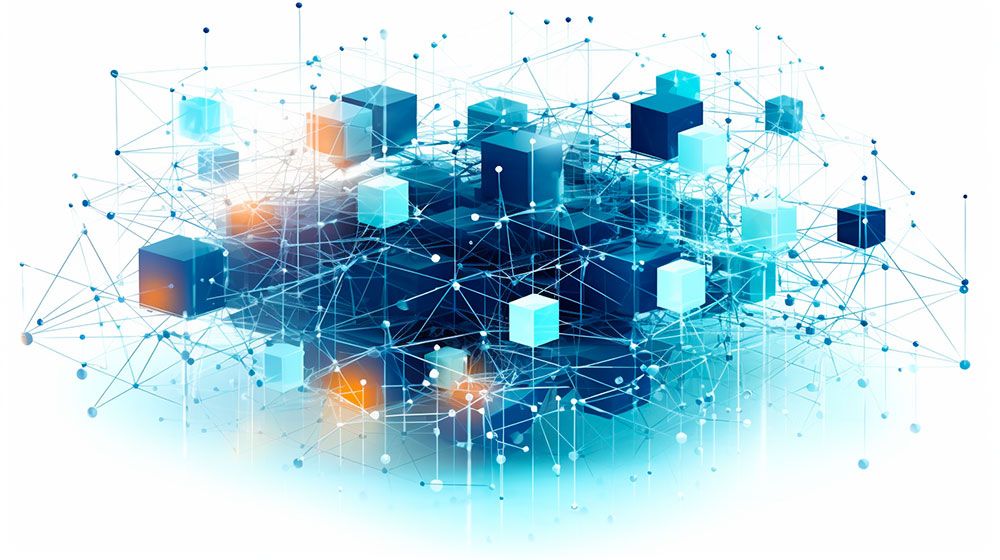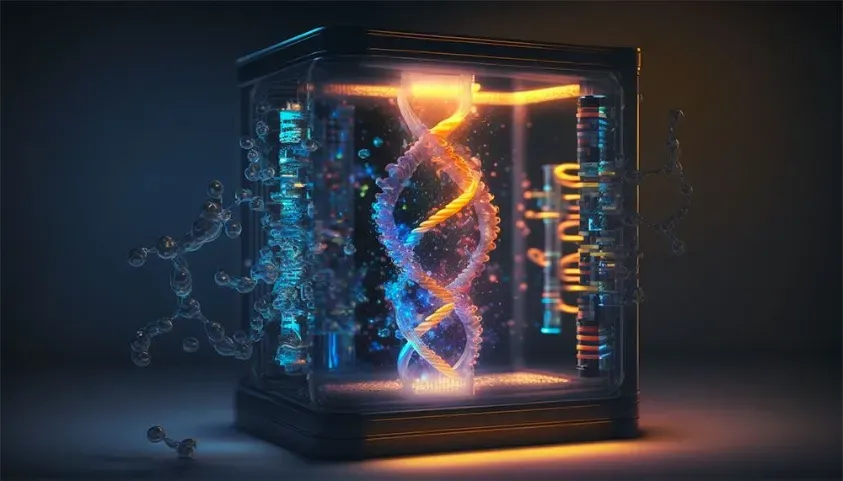5 Ways Big Data Will Improve Civil Infrastructure
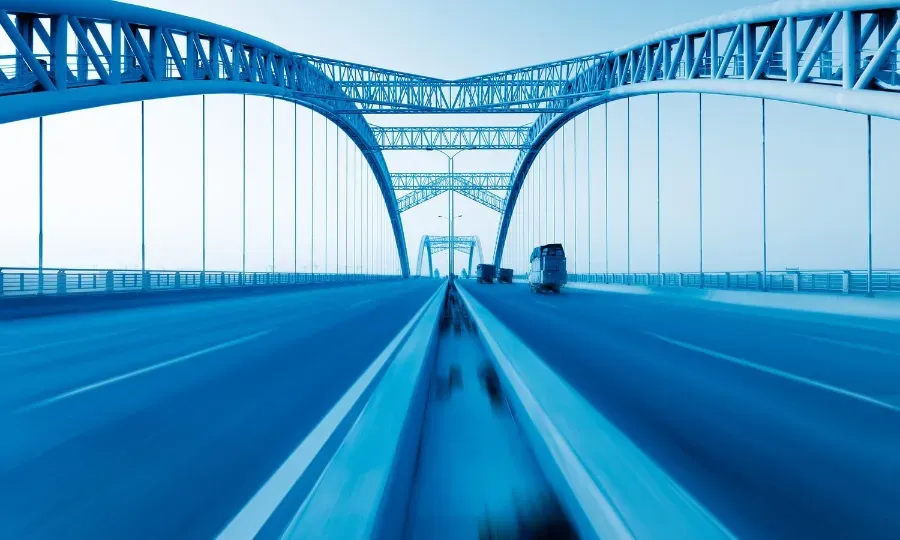
On August 1, 2007 as people were driving home from work on the I-35W Mississippi River Bridge near Minneapolis, it all of a sudden collapsed. Thirteen people died and 145 people were injured. The bridge was constructed in 1967 and was expected to carry 66.000 vehicles per day. However, in 2004 an estimated 141.000 vehicles crossed the bridge on a daily basis. That’s a big difference and turned out to be too much.
The quality of the civil infrastructure within a country, determines its economic possibilities as well as a society’s wealth and quality of life. Therefore, if the infrastructure such as roads, rail tracks and bridges are deteriorating, it could have a big impact on a society. The Federal Highway Administration reported that the costs resulting from the loss of a critical bridge or tunnel could exceed $10 billion.
As the Civil Infrastructure System Task Group of the National Science Foundation once stated: “A civilization that stops investing in its infrastructure takes the first step toward decline”. Infrastructure is important, but also expensive. Fortunately, Big Data can help to bring down costs while improving safety. Let’s have a look:
Monitoring Dikes to Prevent Flooding
In The Netherlands, the IJkdijk has been a decade-long project to improve dike monitoring and to develop sensor network technologies for early warning systems in case a dike is about to break. The initiative brought together a wide range of organizations that together worked on combining dike technology with sensors and data technology. This has resulted in a unique dike monitoring system that can highlight the conditions of a dike.
A central part of this is a system - the Dike Data Service Centre (DDSC) - that stores the data from the monitoring activities centrally and uniformly, which makes it suitable for analysis and processing.
The data derived from the high-tech dikes can also be used to detect many water-related environmental facts that affect the health of humans such as biological changes or pollutions. Also disasters on rivers and coastal waters can be detected.
The Smart Bridge is the Bridge of the Future
Of course what can be done for dikes, can also be done for other infrastructures such as bridges. Monitoring bridges’ structural health is more important than ever. In the USA alone it is estimated that 25% of the country’s 600.000 bridges have structural problems or obsolete design. Fortunately, falling costs in wireless sensors are enabling real-time monitoring of bridges and there are already several great examples of smart bridges around the world.
The Hollandse Brug
Again in The Netherlands, the Dutch government had to close the Hollandse Brug (Holland Bridge) for freight transportation in 2007. The bridge is one of the busiest highway bridges in The Netherlands and closing it cost a lot of money for the Dutch society.
When they were replacing the bridge deck and improving the construction of the bridge, they also installed 145 sensors. The sensors, ranging from vibration sensors, strain gauges to thermometers where embedded in the concrete and placed on the outside. Together these sensors create 1 terabyte of data per day and monitor the condition of the bridge in real-time.
In addition, a local weather station next to the bridge and (smart) camera’s monitor the environment and the traffic flow. Together a complete picture of the condition of the bridge is created in real-time, which enables the Dutch Roads Authority to keep the bridge safe and open.
The New St. Anthony Falls Bridge in Minneapolis
In 2008 just a year after the collapse of the old bridge, the new bridge was opened. This time it was a smart bridge, which was equipped with over 300 sensors. These sensors measure effects of corrosion, weather conditions, horizontal and vertical movements and traffic conditions. The bridge’s temperature sensors can even communicate with antifreeze spray to prevent the bridge from icing up.
All those sensors create massive amounts of data that are used to monitor the bridge’s condition in real-time. In addition, the data is analysed to better understand how a bridge handles all the stresses. That information will be used to improve the design of new bridges in order to be better able to handle all the stresses.
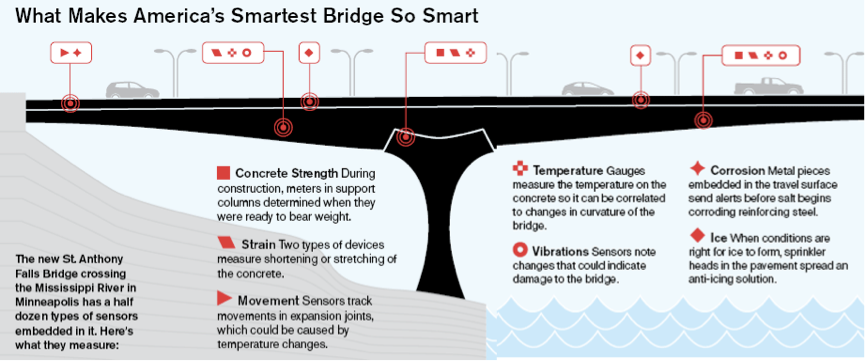
Source: Businessweek
The 2nd Jindo Bridge in South Korea
The Jindo Bridges are twin cable-stayed bridges, which connect Jindo Island and the southwestern tip of Korean Peninsula. The second bridge was constructed in 2006 to accommodate the increasing traffic loads. It is a three-span steel-box girder cable-stayed bridge composed of a 344 m of main span and 70 m of side spans. It is also a smart bridge that is equipped with 113 sensors nodes that can measure acceleration, temperature, humidity, light, and wind effects on the bridge.
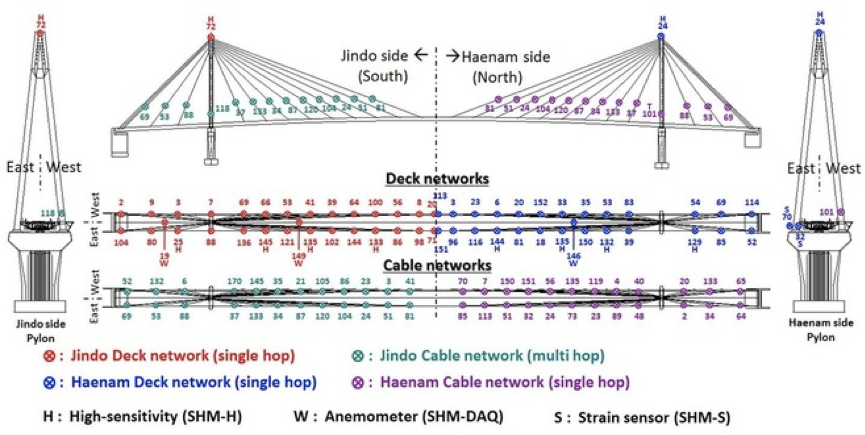
The second Jindo Bridge has 15 thermometers, 15 strain gages, four biaxial inclinometers, two string pots, two laser displacement meters, 24 Fiber Bragg Grating sensors, 20 uniaxial capacitive accelerometers, two biaxial force balance type accelerometers, and three triaxial seismic accelerometers. Together, all these sensors collect vast amounts of data that are used to constantly monitor the bridge as well as conduct scientific research.
The interesting aspect of the sensor monitoring system on the 2<sup>nd</sup> Jindo Bridge is that it uses wireless sensors that are easy to deploy and create smart structures. The best practices from this bridge can therefore be used to, relatively easily, turn bridges into smart bridges.
5 Benefits of Smart Civil Infrastructure
Dikes and bridges are only a few examples of smart civil infrastructure. Basically any infrastructure can be upgraded with sensors to become smart and provide real-time insights. In essence there are five advantage that smart civil infrastructure will bring:
1. Improved Monitoring of Infrastructure
Until recently, monitoring of infrastructure had to be done at location and at regular intervals. This is very expensive and labour intensive. With only 600.000 bridges in the USA alone, it is a daunting task. Bridges equipped with sensors can monitor a wide range of variables automatically and in real-time, saving a lot of work and money.
2. Improved and Cheaper (Predictive) Maintenance
Bridges equipped with monitoring systems can indicate that maintenance is required, far in advance. This will significantly improve the quality of the bridge, while it will prevent unexpected bridge closures as happened in The Netherlands.
3. Improved Safety
Of course, infrastructure that is monitored 24/7 will be safer to use than infrastructure that is only monitored a few times a year. In addition, thanks to predictive maintenance, the structure will be in better condition, creating a safer environment. Finally, also safe driving conditions can be created, as was done with the New St. Anthony’s Fall Bridge, where sensors can activate antifreeze spray and thereby significantly improving road conditions in bad weather.
4. Reduced Operational Costs
Smart infrastructure will be a lot cheaper to operate. Monitoring can be done from a central location, in real-time in any weather condition. The cost savings through well-scheduled and targeted maintenance are significant (early maintenance is 5x cheaper than late repair).
5. Additional Environmental Insights
Infrastructure that is equipped with high-tech sensors can also provide significant information related to traffic conditions, economic or demographic changes or even changing environmental factors. This information can be used to improve regulation and gain a better understanding at certain economic conditions.
The Infrastructure of the Future
In the future, infrastructure will be able to monitor in real-time its own health via a complex network of (high-tech) sensors. It will be able to provide an estimate of its structural integrity and even take, automatically, corrective action if necessary.
When the data from the sensors are combined with other data sources such as climate data, economic data, traffic (video) data it will be possible to predict future impact on the infrastructure and the environment, while reducing, operational costs and significantly improving safety.




